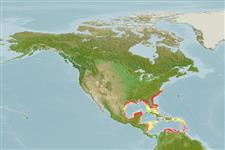Teleostei (teleosts) >
Ophidiiformes (Cusk eels) >
Ophidiidae (Cusk-eels) > Ophidiinae
Etymology: Otophidium: Greek, ous, oto = ear + Greek, ophis, diminutive = serpent (Ref. 45335).
More on authors: Jordan & Gilbert.
Environment: milieu / climate zone / depth range / distribution range
Ecology
Marine; demersal; depth range 10 - 50 m (Ref. 7251). Subtropical; 37°N - 10°N
Western Atlantic: North Carolina to Florida and the northern Gulf of Mexico; also in the Lesser Antilles; extending to northern South America (Ref. 5217).
Size / Weight / Age
Maturity: Lm ? range ? - ? cm
Max length : 12.9 cm SL male/unsexed; (Ref. 13608)
Dorsal spines (total): 0; Dorsal soft rays (total): 102 - 106; Anal spines: 0; Anal soft rays: 82 - 85. A distinct black blotch present just above gill cover; two or three rows of dark brownish blotches on body; dorsal fin with blackish blotches along margin; anal black; caudal pale; snout spine situated between posterior nostril and covered with skin; anal wide, flat spine on opercle; gill rakers short (Ref. 13608).
Uncommon species (Ref. 34024). Oviparous, with oval pelagic eggs floating in a gelatinous mass (Ref. 205). Minimum depth from Ref. 37039.
Life cycle and mating behavior
Maturities | Reproduction | Spawnings | Egg(s) | Fecundities | Larvae
Nielsen, J.G., D.M. Cohen, D.F. Markle and C.R. Robins, 1999. Ophidiiform fishes of the world (Order Ophidiiformes). An annotated and illustrated catalogue of pearlfishes, cusk-eels, brotulas and other ophidiiform fishes known to date. FAO Fish. Synop. 125(18):178p. Rome: FAO. (Ref. 34024)
IUCN Red List Status (Ref. 130435)
Threat to humans
Harmless
Human uses
Fisheries: of no interest
Tools
Special reports
Download XML
Internet sources
Estimates based on models
Preferred temperature (Ref.
123201): 22.9 - 27, mean 24.2 °C (based on 124 cells).
Phylogenetic diversity index (Ref.
82804): PD
50 = 0.5625 [Uniqueness, from 0.5 = low to 2.0 = high].
Bayesian length-weight: a=0.00257 (0.00122 - 0.00544), b=3.17 (2.99 - 3.35), in cm total length, based on LWR estimates for this (Sub)family-body shape (Ref.
93245).
Trophic level (Ref.
69278): 3.5 ±0.6 se; based on size and trophs of closest relatives
Resilience (Ref.
120179): High, minimum population doubling time less than 15 months (Preliminary K or Fecundity.).
Fishing Vulnerability (Ref.
59153): Low vulnerability (10 of 100).
